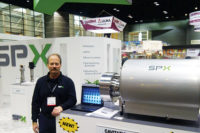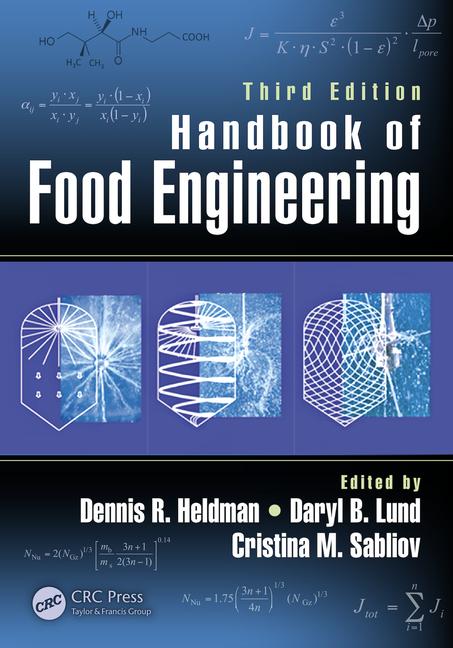
Richard Walden, director, Zinetec Ltd., Oxfordshire, UK
The process, developed by Richard Walden, relies on rapid back-and-forth movement of the retort's basket on a track for agitation. A G-force of as little as 0.5 generates significantly more agitation than rotating cans on their cylindrical or longitudinal axis. Likewise, heat removal is accelerated, resulting in less thermal abuse and product quality similar to aseptic, the company claims.
Walden, director of Zinetec Ltd., worked in process engineering for 30 years at Carnaud Metalbox, where he and collaborator Robin Ferguson developed the reciprocal thermal process. He joined Metalbox after graduating with a degree in chemistry from the University of Leicester in the East Midlands. In Cologne, Satori Stocktec GmbH exhibited the first commercial retort employing the technology.
FE:When did you begin working on reciprocal-motion retort?
Walden:The original idea came to me around 1993, when I was working at Carnaud Metalbox in the UK. Oddly enough, it came out of aseptic technology, which is terribly complicated and hasn't developed as well as expected in part because there often isn't the engineering support needed on site to make it practical. Retort, on the other hand, is very understandable technology.
While rotary systems are faster than static retorts, the turbulence produced doesn't optimize heat transfer. There's plenty of heat on the outside and along the walls of a container in a retort. There had to be a way to get more heat into the product, and the solution we came up with was rapid agitation, back and forth.
FE:Is it simply a matter of faster agitation?
Walden:More uniform product mixing is another advantage with horizontal re- ciprocation. When we first put thermocouples in cans in the lab, the temperature went up before our eyes. Come-up time is reduced, and once sterilization temperature is reached, changes in acceleration have little impact. One baby-food manufacturer said the process results in product quality similar to aseptic.
FE:More than a decade elapsed since your initial work on the reciprocating retort. What delayed it?
Walden:It was an unfortunate time in the history of Metalbox. They were making people redundant, and the acquisition by Crown in 1996 squelched this. Working with UTEK Europe Ltd., we bought back the patent in 2001. Two years ago, we approached Campden & Chorleywood Food Research Association and they built a lab-scale reciprocating retort. In early 2005, tests involving manufacturers' products began.
FE:Had anyone tried to apply reciprocal motion to retort before this?
Walden:We didn't learn about it until later, but Frank Gerber of the Fremont, MI, baby-food company patented a reciprocating cooker for sterile canned food in 1938. But he was agitating the whole retort, swinging it from side to side to create agitation. You have to get to a certain level of agitation before you get a breakthrough on time, and he didn't generate enough speed to achieve that breakthrough.
We've run comparisons of our reciprocating motion to rotary and static retorts, and the improvements are dramatic. For example, leek and potato soup was processed almost three times faster in a rotary system compared to static: come-up time was 7 minutes, sterilization took 29 minutes, and cool down was 14 minutes. With the Shaka process, come-up was 2 minutes, sterilization 2.5 and cooling was done in 3 minutes. That's almost seven times faster.

Rapid back-and-forth motion creates sufficient agitation in a standard retort to significantly reduce processing time. Source: UTEK Europe Ltd.
Walden:I haven't done the calculations, but my feeling is that the contribution of friction would be minute. Virtually all the thermal energy is coming in from the outside of the container; by creating rapid agitation, we've turned the container into a heat exchanger. Instead of flowing product by the wall, you're stirring it away and getting cold product against the wall. The whole product comes up evenly. Each particle of the product is getting the minimum amount of heat needed to sterilize it. And just as heating is very efficient, cool-down is efficient, as well. Agitating the product against a cold outside wall takes away heat very quickly.
FE:Is reciprocal motion more appropriate for some products?
Walden:It's really aimed at conduction products, the more viscous foods that don't move in a static retort and take a long time to cook. With thin products, convection currents are generated even without agitation. Waves are created as heat from the bottom rises and falls down along the interior walls of the container. The process is relatively quick, which moderates the benefits of rapid agitation.
FE:Does reversing the momentum of the basket pose a mechanical challenge for reciprocal agitation?
Walden:The force isn't that great. The stroke is about 6 inches and at most we get up to 150 RPMs, which generates just over 3 Gs. If the retort basket is half a ton, the force is 1.5 tons. You don't need anything huge to restrain the loads.
FE:Still, a back-and-forth cycle every 0.4 seconds is significant. Is servo technology necessary to control it?
Walden:Servos, hydraulics, loads and loads of ways are available for doing it. Our licensing partners could come up with all sorts of solutions. You can sketch up all sorts of good, bad and indifferent ways to drive the baskets back and forth. We probably came up with 50 in a couple of hours in the lab before settling on a mechanical approach.
FE:How does the lab-scale system agitate the load?
Walden:It's really just a crankshaft and slider mechanism that rotates, with a cam rod that goes through. Victorian engineering, I call it. It's a very simple mechanical approach; you just have to make the mechanical bits strong enough. Our German licensee, Satori Stocktec, used a similar approach for the one-basket retort displayed at Anuga FoodTec. Throughput on that machine would be similar to a five-basket rotary or eight-basket static retort. Satori's unit could output four, five, six baskets an hour, with 400 cans per basket. A two-basket machine would be a production-sized machine.
FE:Rapid product loading and unloading must be critical for optimizing system performance.
Walden:Yes, and our licensing partners are bringing that to the party. There's not much value in reducing processing time to 10 minutes if it takes 15 minutes to load and unload the retort. Because the process is so short, you need to be able to do that quickly. We're dependent on the equipment integrators to develop robotic or mechanical solutions. We have three licensees to give the processors of the world a choice of suppliers, but we won't have more than four. They have to have an incentive to develop the systems around this technology. If you license everybody, development doesn't occur.
FE:Process validation is an issue for US aseptic approval. What regulatory barriers exist for reciprocal retort?
Walden:FDA tells us they do not regard this as a novel process. Validation requirements are going to be the same as with a conventional retort and will parallel the procedure for a rotary retort. Controlling head space and the viscosity of the product going into the container are critical, which obviously applies to rotary units, as well.
The controls system is no more complicated than with a normal retort. PLCs and existing control technology will be fine for monitoring crank rotation.
FE:Will plastic pouches and other non-metallic containers withstand the force of reciprocating motion?
Walden:We've done glass jars and plastic bowls with steam-air mix to deliver overpressure. Plastic has some impact on processing time, though not much; glass is a worse conductor of heat. But pouches are very thin, perhaps 0.003 inches thick, so there isn't much impediment to heat transfer.



